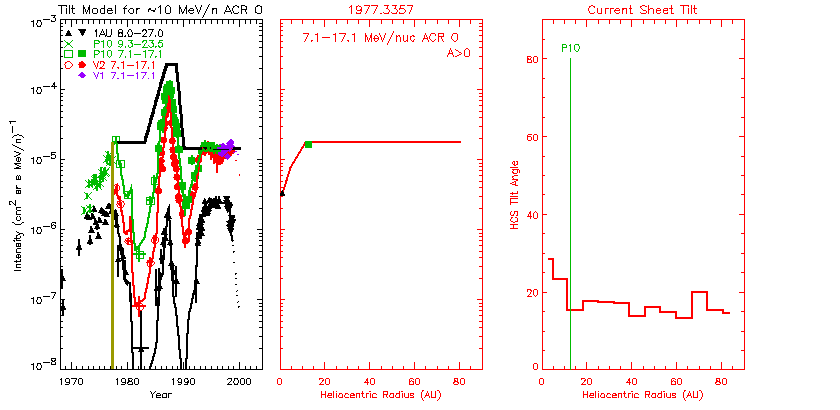

We have constructed a model for the modulation of ~3 GV anomalous
cosmic ray (ACR) oxygen at low heliographic latitudes which depends only on a knowledge of:
1) the
time history of the LOS tilt angle
of the current sheet from the
Wilcox Solar Observatory,
2) the
relationship
between the radial gradient of ACR O and the tilt angle,
3) the radial scaling of this relationship, i.e., Gr = f(tilt)*(r/robs)-n,
4) the radial gradient inside ~11 AU, which does not depend on tilt,
5) the solar wind speed (used to convect the tilts outward from the Sun),
6) the shock location, and
7) the intensity of ACR O at the shock.
By fitting the 1985-1989 data, we find that for VSW = 440 km/s, the best-fit n = 0.82 and the best-fit shock location is 83.7 AU. Using these values, the left panel shows the time-dependence of the 1 AU, V2, V1 (only plotted after P10 ceased returning data in 1996), and P10 ACR O intensity vs time from 1968 to the present. The open symbols for V2 and P10 are observed values; the filled symbols are corrected for latitude gradients to the heliographic equator. After mid-1996, when there was no longer P10 data available with which to calculate a latitiudinal gradient in the outer heliosphere, we corrected V1 and V2 intensities to the heliographic equator assuming the latitude gradient was 2.5%/deg, the typical value for the recent past. The lines are from the model and pass reasonably well through the data. The upper black line is the intensity at the shock.
There are 287 frames in the movie; each frame represents 27.25 days = a Carrington rotation. The movie begins at 1977.34 (just prior to the launches of V1 and V2) and continues through 1998.69. A vertical line in the left panel moves along to indicate which Carrington rotation is being displayed in the middle and right panels. The middle panel is the radial profile of the intensity; the data are interpolated to the midpoint of the Carrington rotation from the data points in the left panel. The right panel shows the radial dependence of the tilt angle of the heliospheric current sheet for each Carrington rotation.
Note that the model is for global modulation and does not include short term transient modulation effects, such as Forbush decreases, so there are occasionally transient differences between the global model and the observations.
Authored by Alan Cummings
and Ed Stone.
Return
to Alan Cummings' homepage.
http://www.srl.caltech.edu/personnel/ace.html